Abstract
Previous research has shown that self-injurious behavior (SIB) maintained by positive reinforcement may be reduced under differential-reinforcement-of-other-behavior (DRO) contingencies. In this study, we conducted an analysis of the reinforcement and extinction components of DRO while treating the self-injury of 3 women with developmental disabilities. A functional analysis revealed that each subject's SIB was maintained by positive reinforcement in the form of attention. Subsequent reinforcer assessments identified preferred and nonpreferred stimuli for later use in conjunction with DRO. Results showed high rates of SIB for all 3 subjects during baseline, which persisted when DRO was implemented without the relevant extinction component (withholding of attention for SIB) for 2 of the subjects. Low rates of SIB were observed for all subjects when DRO plus extinction was implemented or when extinction was implemented alone, suggesting that extinction may be a critical component of DRO schedules.
Full text
PDF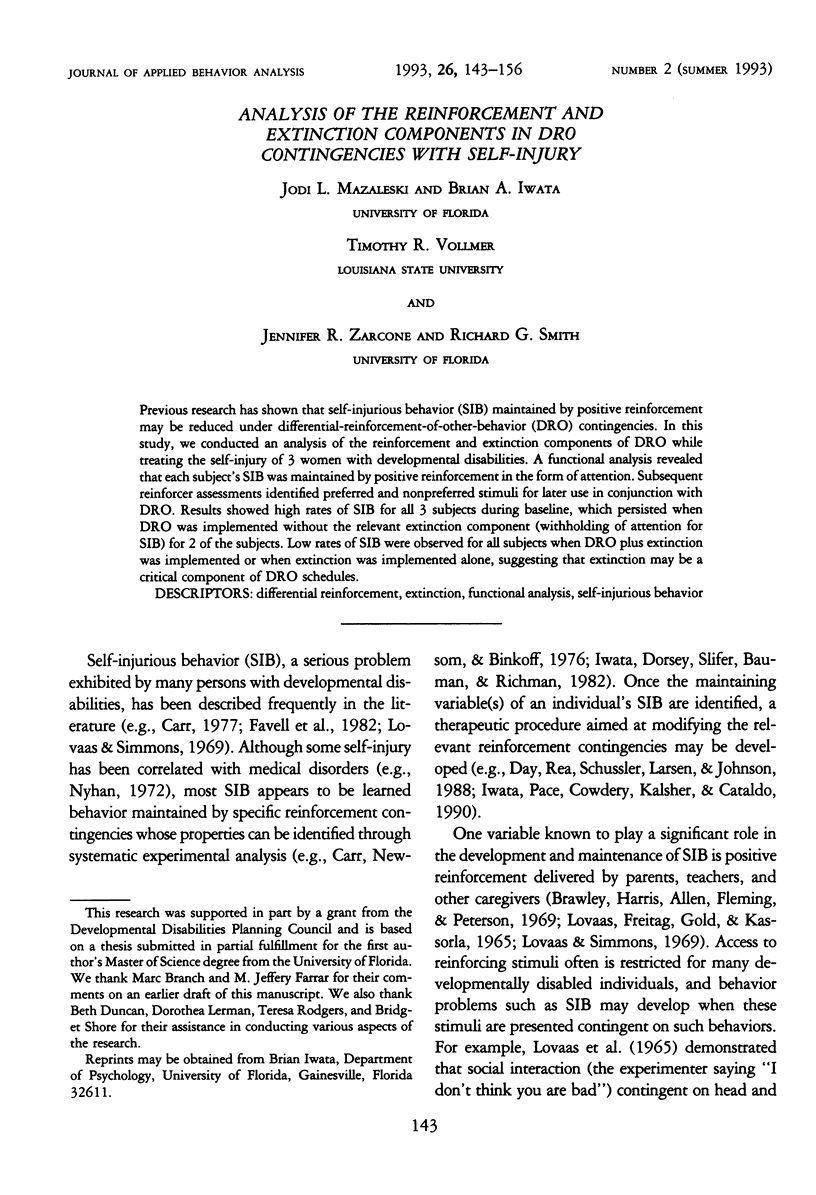
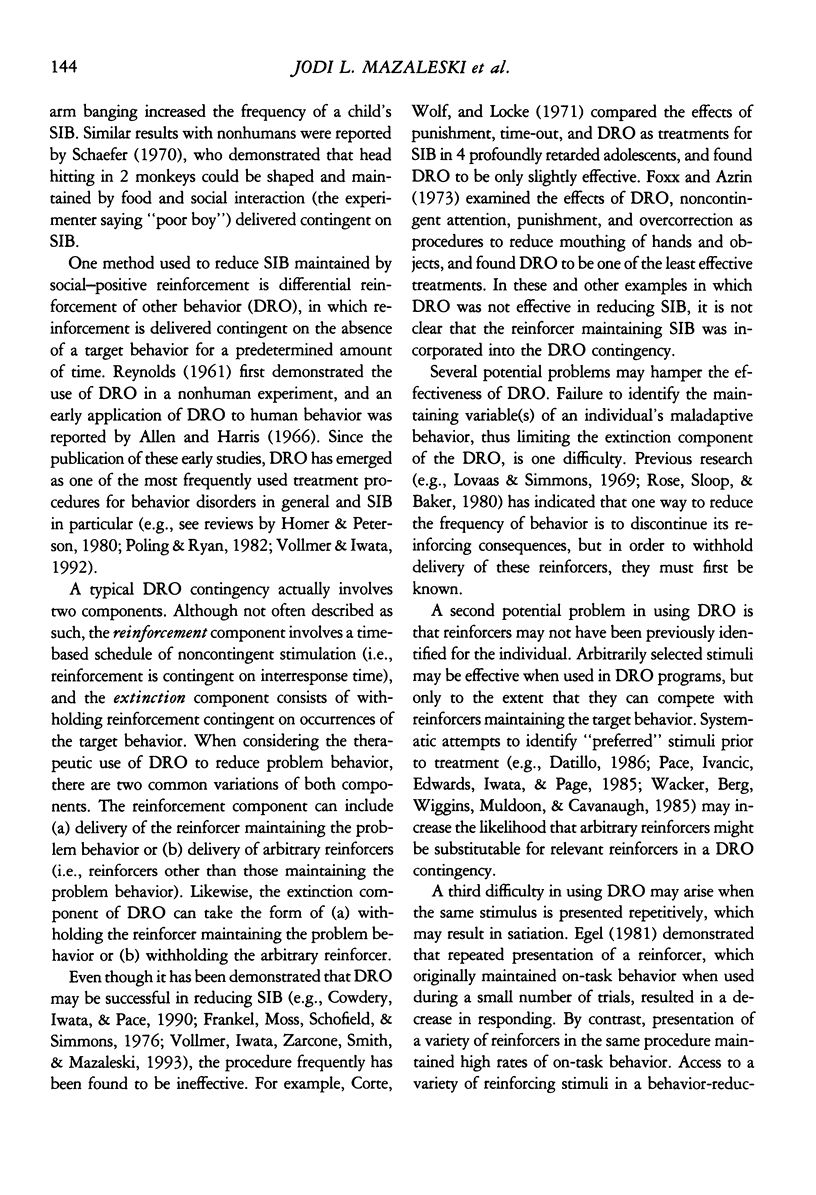
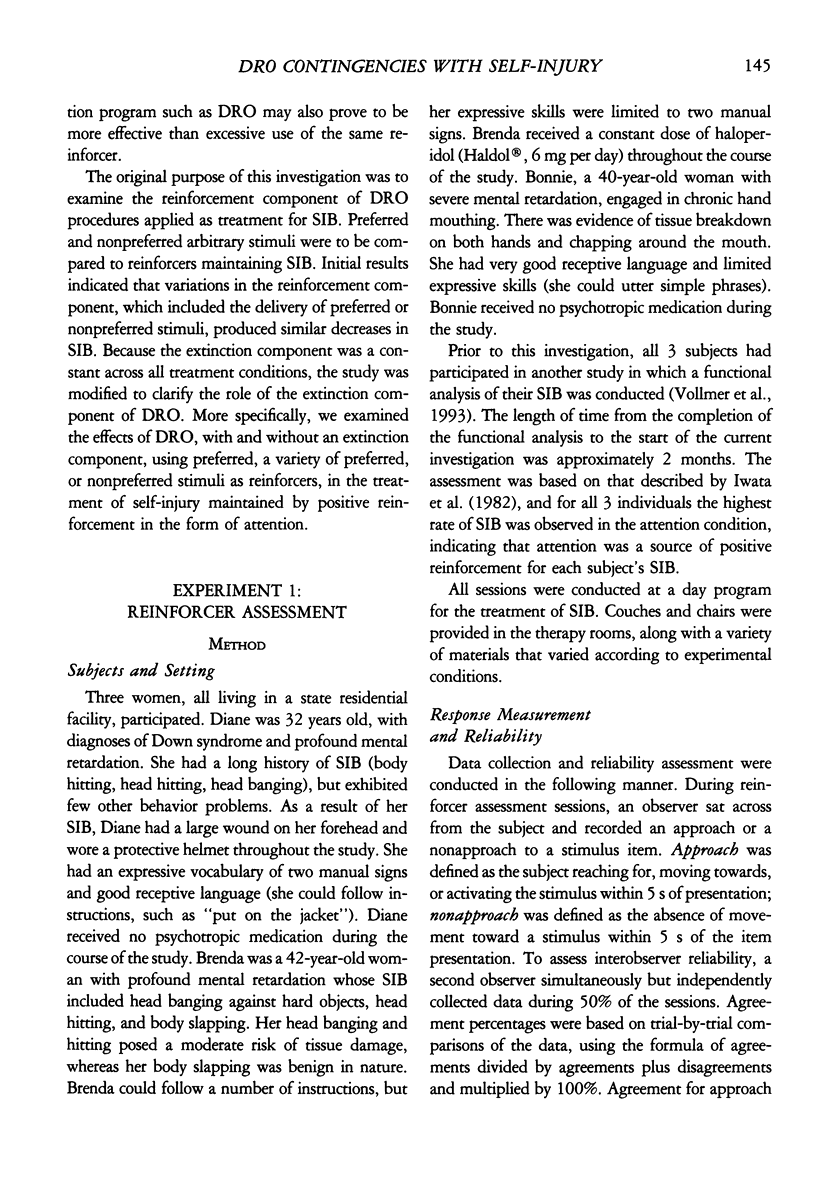
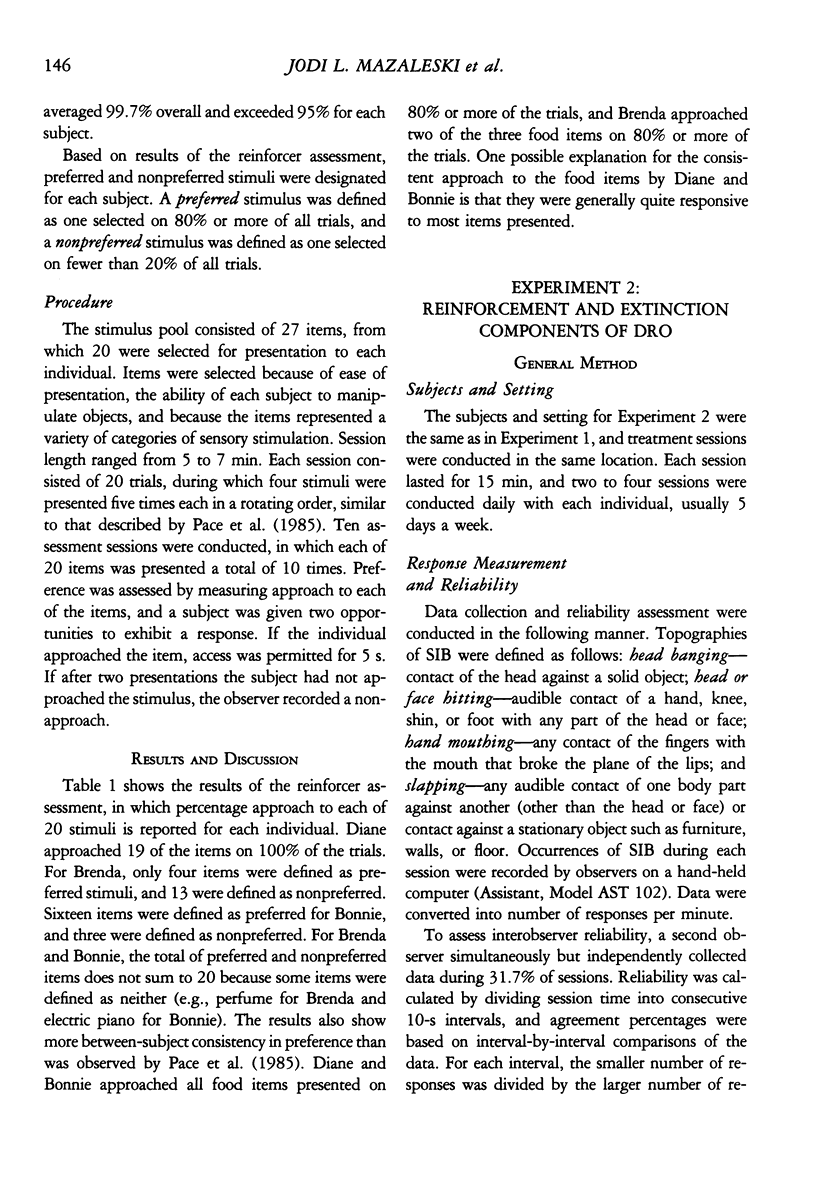
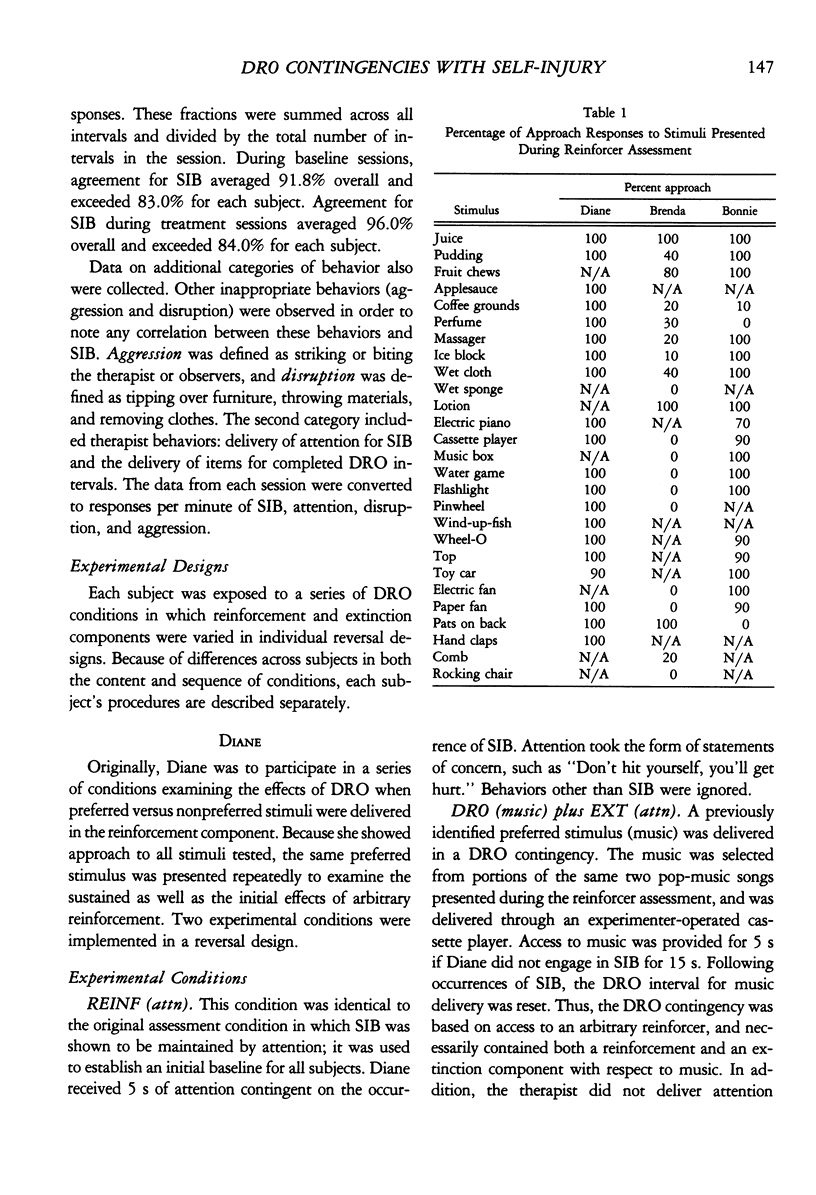
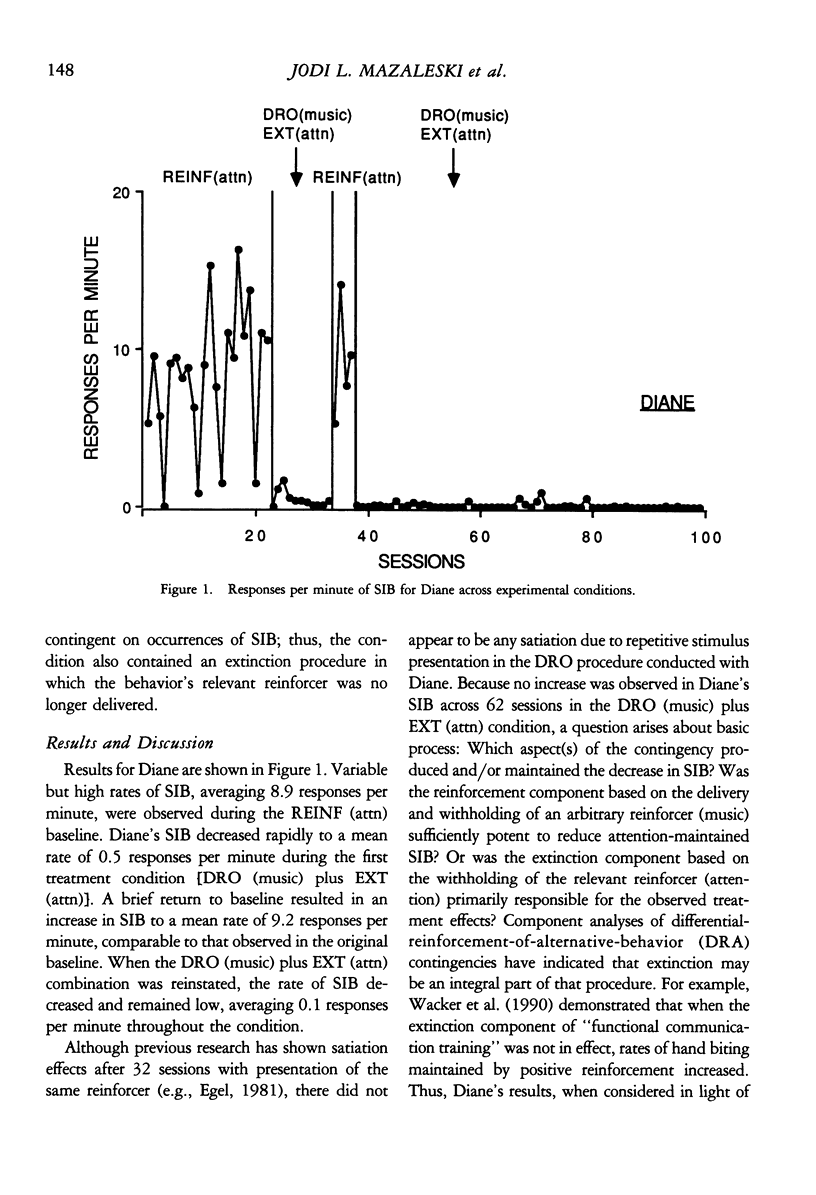
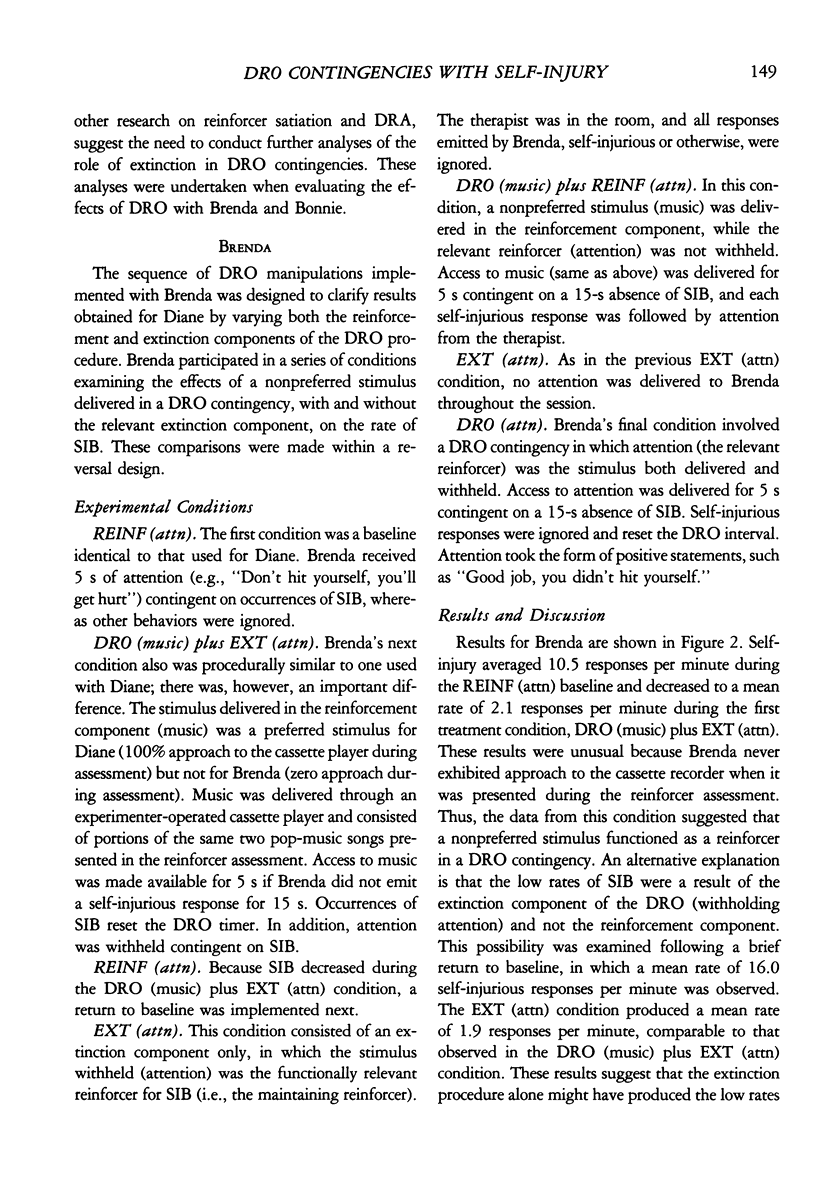
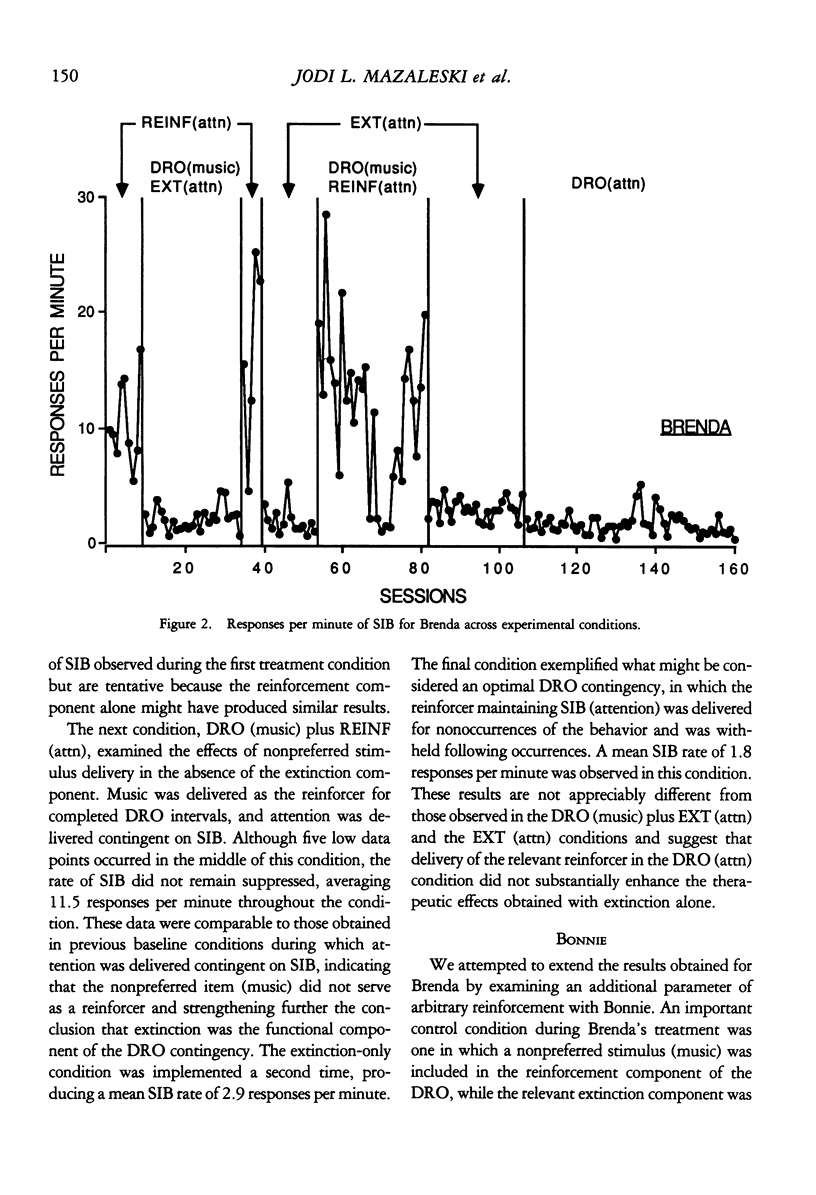
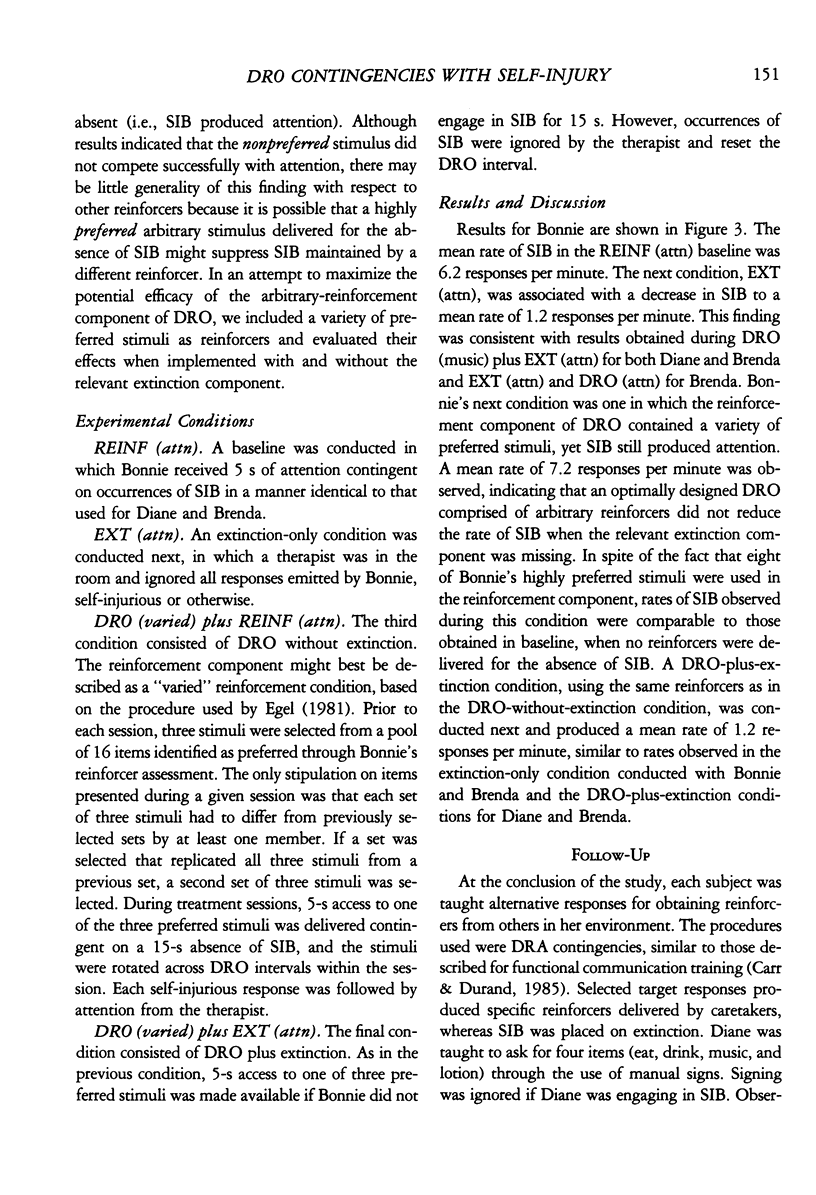
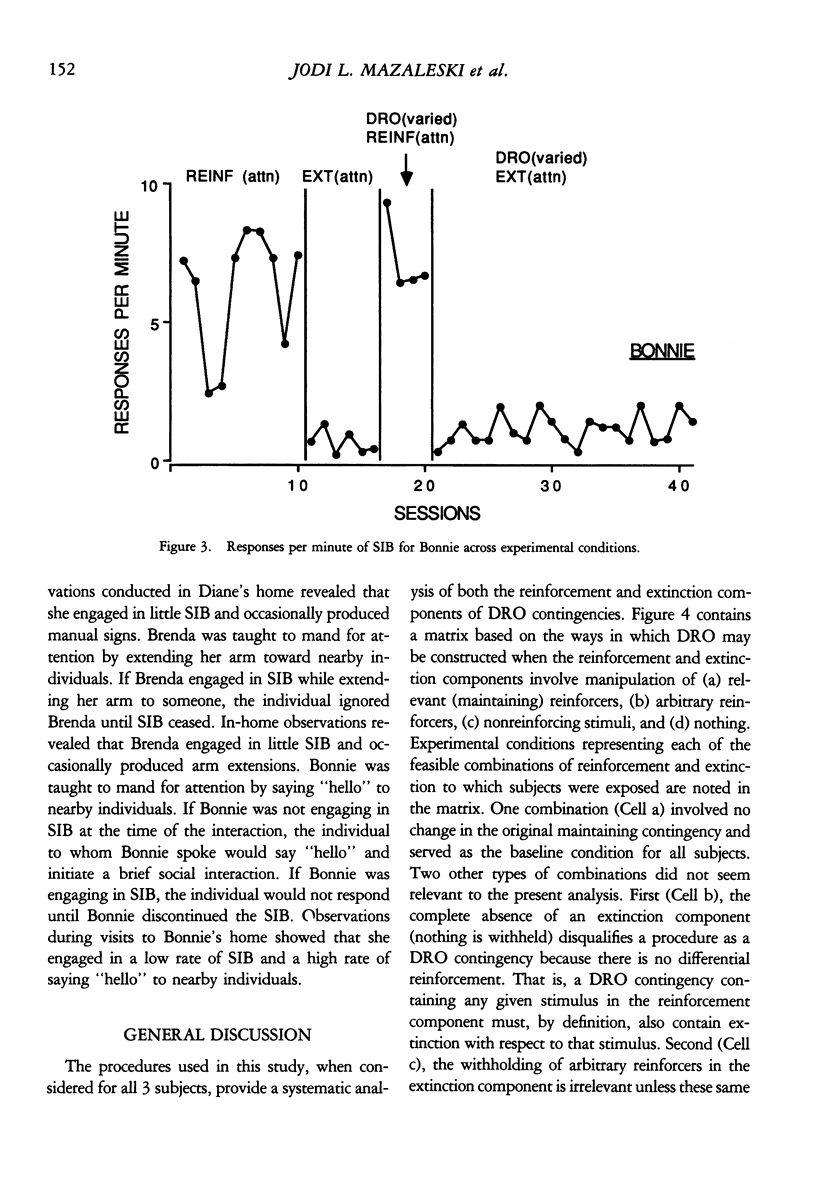
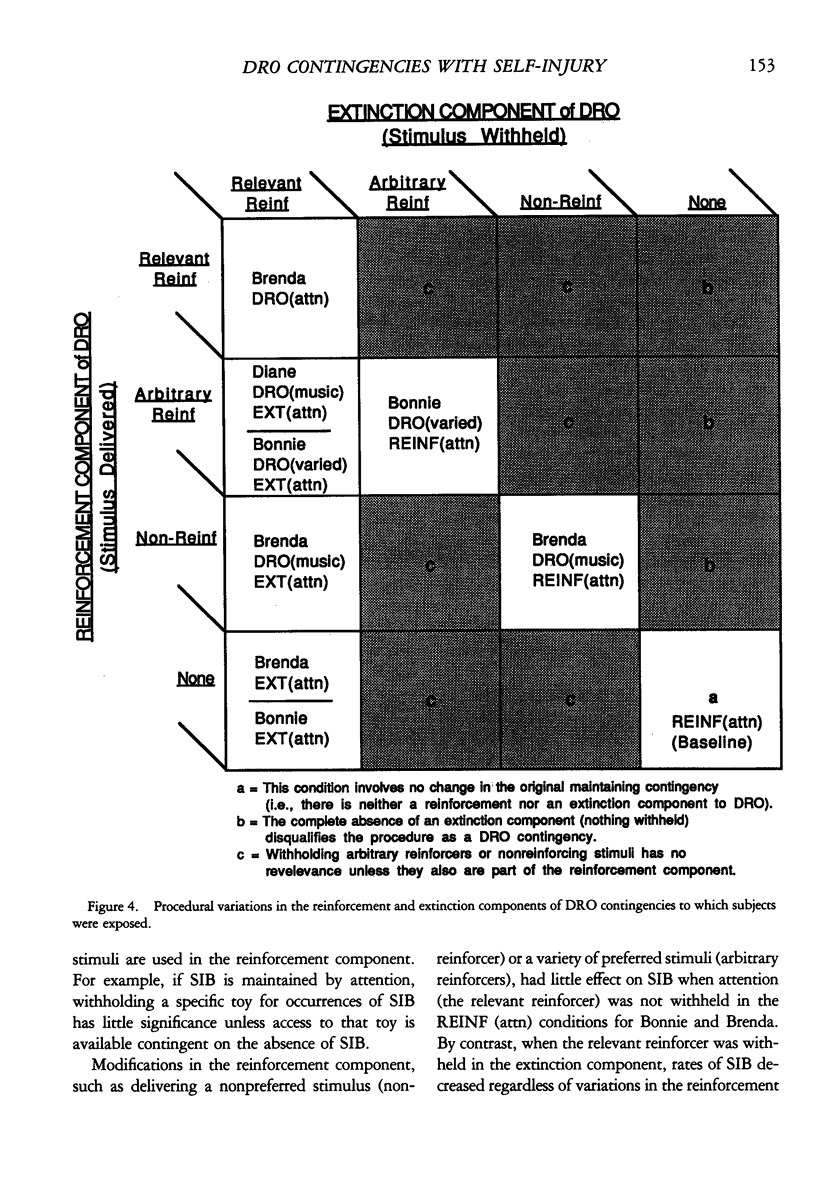
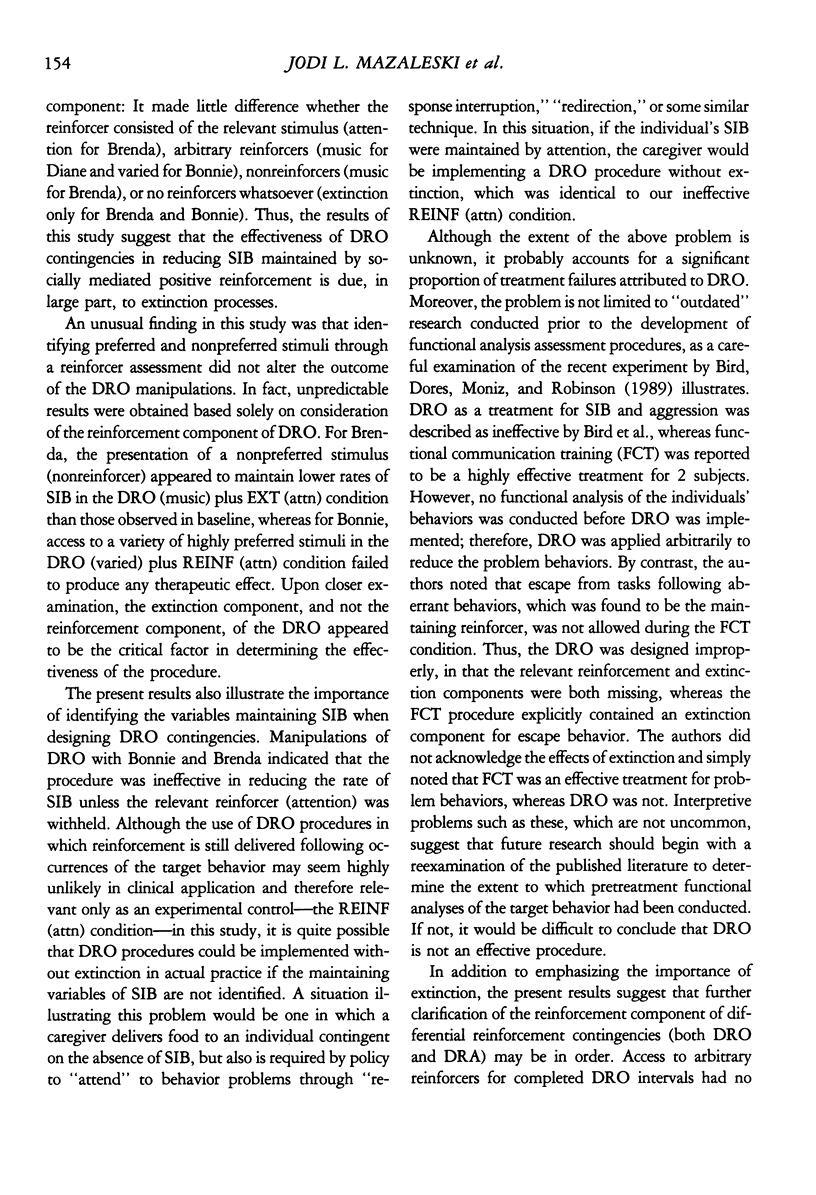
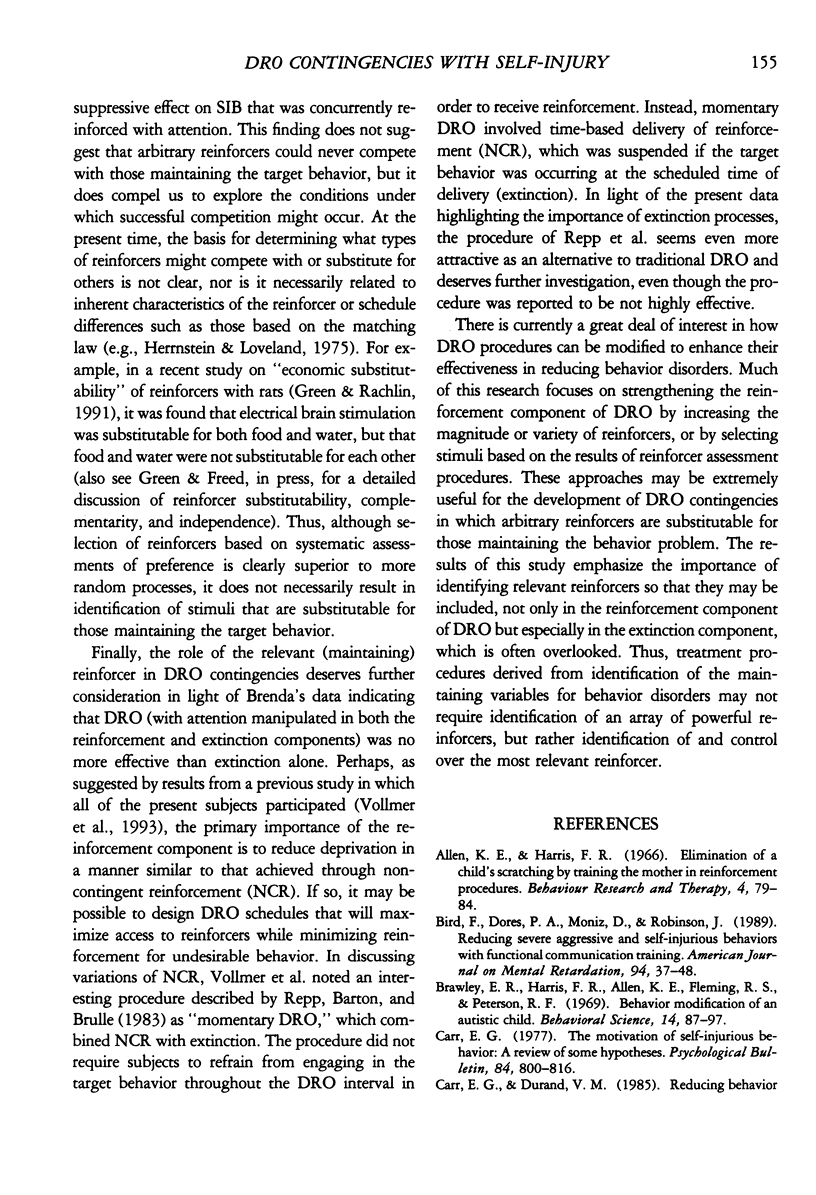
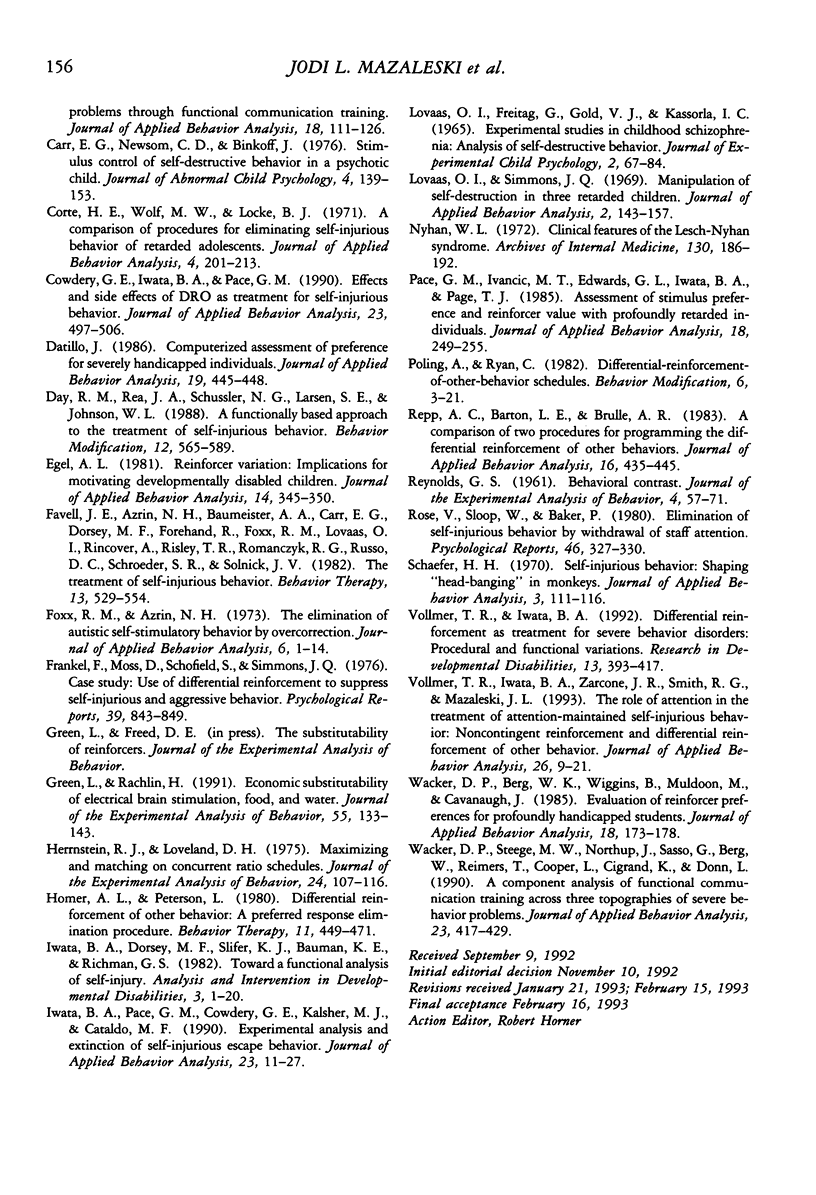
Selected References
These references are in PubMed. This may not be the complete list of references from this article.
- Allen K. E., Harris F. R. Elimination of a child's excessive scratching by training the mother in reinforcement procedures. Behav Res Ther. 1966 May;4(2):79–84. doi: 10.1016/0005-7967(66)90046-5. [DOI] [PubMed] [Google Scholar]
- Bird F., Dores P. A., Moniz D., Robinson J. Reducing severe aggressive and self-injurious behaviors with functional communication training. Am J Ment Retard. 1989 Jul;94(1):37–48. [PubMed] [Google Scholar]
- Brawley E. R., Harris F. R., Allen K. E., Fleming R. S., Peterson R. F. Behavior modification of an autistic child. Behav Sci. 1969 Mar;14(2):87–97. doi: 10.1002/bs.3830140202. [DOI] [PubMed] [Google Scholar]
- Carr E. G., Durand V. M. Reducing behavior problems through functional communication training. J Appl Behav Anal. 1985 Summer;18(2):111–126. doi: 10.1901/jaba.1985.18-111. [DOI] [PMC free article] [PubMed] [Google Scholar]
- Carr E. G., Newsom C. D., Binkoff J. A. Stimulus control of self-destructive behavior in a psychotic child. J Abnorm Child Psychol. 1976;4(2):139–153. doi: 10.1007/BF00916518. [DOI] [PubMed] [Google Scholar]
- Carr E. G. The motivation of self-injurious behavior: a review of some hypotheses. Psychol Bull. 1977 Jul;84(4):800–816. [PubMed] [Google Scholar]
- Corte H. E., Wolf M. M., Locke B. J. A comparison of procedures for eliminating self-injurious behavior of retarded adolescents. J Appl Behav Anal. 1971 Fall;4(3):201–213. doi: 10.1901/jaba.1971.4-201. [DOI] [PMC free article] [PubMed] [Google Scholar]
- Cowdery G. E., Iwata B. A., Pace G. M. Effects and side effects of DRO as treatment for self-injurious behavior. J Appl Behav Anal. 1990 Winter;23(4):497–506. doi: 10.1901/jaba.1990.23-497. [DOI] [PMC free article] [PubMed] [Google Scholar]
- Dattilo J. Computerized assessment of preference for severely handicapped individuals. J Appl Behav Anal. 1986 Winter;19(4):445–448. doi: 10.1901/jaba.1986.19-445. [DOI] [PMC free article] [PubMed] [Google Scholar]
- Day R. M., Rea J. A., Schussler N. G., Larsen S. E., Johnson W. L. A functionally based approach to the treatment of self-injurious behavior. Behav Modif. 1988 Oct;12(4):565–589. doi: 10.1177/01454455880124005. [DOI] [PubMed] [Google Scholar]
- Egel A. L. Reinforcer variation: implications for motivating developmentally disabled children. J Appl Behav Anal. 1981 Fall;14(3):345–350. doi: 10.1901/jaba.1981.14-345. [DOI] [PMC free article] [PubMed] [Google Scholar]
- Foxx R. M., Azrin N. H. The elimination of autistic self-stimulatory behavior by overcorrection. J Appl Behav Anal. 1973 Spring;6(1):1–14. doi: 10.1901/jaba.1973.6-1. [DOI] [PMC free article] [PubMed] [Google Scholar]
- Frankel F., Moss D., Schofield S., Simmons J. Q. Case study: use of differential reinforcement to suppress self-injurious and aggressive behavior. Psychol Rep. 1976 Dec;39(3):843–849. doi: 10.2466/pr0.1976.39.3.843. [DOI] [PubMed] [Google Scholar]
- Green L., Rachlin H. Economic substitutability of electrical brain stimulation, food, and water. J Exp Anal Behav. 1991 Mar;55(2):133–143. doi: 10.1901/jeab.1991.55-133. [DOI] [PMC free article] [PubMed] [Google Scholar]
- Herrnstein R. J., Loveland D. H. Maximizing and matching on concurrent ratio schedules. J Exp Anal Behav. 1975 Jul;24(1):107–116. doi: 10.1901/jeab.1975.24-107. [DOI] [PMC free article] [PubMed] [Google Scholar]
- Iwata B. A., Pace G. M., Kalsher M. J., Cowdery G. E., Cataldo M. F. Experimental analysis and extinction of self-injurious escape behavior. J Appl Behav Anal. 1990 Spring;23(1):11–27. doi: 10.1901/jaba.1990.23-11. [DOI] [PMC free article] [PubMed] [Google Scholar]
- Lovaas O. I., Simmons J. Q. Manipulation of self-destruction in three retarded children. J Appl Behav Anal. 1969 Fall;2(3):143–157. doi: 10.1901/jaba.1969.2-143. [DOI] [PMC free article] [PubMed] [Google Scholar]
- Nyhan W. L. Clinical features of the Lesch-Nyhan syndrome. Arch Intern Med. 1972 Aug;130(2):186–192. [PubMed] [Google Scholar]
- Pace G. M., Ivancic M. T., Edwards G. L., Iwata B. A., Page T. J. Assessment of stimulus preference and reinforcer value with profoundly retarded individuals. J Appl Behav Anal. 1985 Fall;18(3):249–255. doi: 10.1901/jaba.1985.18-249. [DOI] [PMC free article] [PubMed] [Google Scholar]
- REYNOLDS G. S. Behavioral contrast. J Exp Anal Behav. 1961 Jan;4:57–71. doi: 10.1901/jeab.1961.4-57. [DOI] [PMC free article] [PubMed] [Google Scholar]
- Repp A. C., Barton L. E., Brulle A. R. A comparison of two procedures for programming the differential reinforcement of other behaviors. J Appl Behav Anal. 1983 Winter;16(4):435–445. doi: 10.1901/jaba.1983.16-435. [DOI] [PMC free article] [PubMed] [Google Scholar]
- Rose V., Sloop W., Baker P. Elimination of chronic self-injurious behavior by withdrawal of staff attention. Psychol Rep. 1980 Feb;46(1):327–330. doi: 10.2466/pr0.1980.46.1.327. [DOI] [PubMed] [Google Scholar]
- Schaefer H. H. Self-injurious behavior: shaping "head banging" in monkeys. J Appl Behav Anal. 1970 Summer;3(2):111–116. doi: 10.1901/jaba.1970.3-111. [DOI] [PMC free article] [PubMed] [Google Scholar]
- Vollmer T. R., Iwata B. A. Differential reinforcement as treatment for behavior disorders: procedural and functional variations. Res Dev Disabil. 1992;13(4):393–417. doi: 10.1016/0891-4222(92)90013-v. [DOI] [PubMed] [Google Scholar]
- Vollmer T. R., Iwata B. A., Zarcone J. R., Smith R. G., Mazaleski J. L. The role of attention in the treatment of attention-maintained self-injurious behavior: noncontingent reinforcement and differential reinforcement of other behavior. J Appl Behav Anal. 1993 Spring;26(1):9–21. doi: 10.1901/jaba.1993.26-9. [DOI] [PMC free article] [PubMed] [Google Scholar]
- Wacker D. P., Berg W. K., Wiggins B., Muldoon M., Cavanaugh J. Evaluation of reinforcer preferences for profoundly handicapped students. J Appl Behav Anal. 1985 Summer;18(2):173–178. doi: 10.1901/jaba.1985.18-173. [DOI] [PMC free article] [PubMed] [Google Scholar]
- Wacker D. P., Steege M. W., Northup J., Sasso G., Berg W., Reimers T., Cooper L., Cigrand K., Donn L. A component analysis of functional communication training across three topographies of severe behavior problems. J Appl Behav Anal. 1990 Winter;23(4):417–429. doi: 10.1901/jaba.1990.23-417. [DOI] [PMC free article] [PubMed] [Google Scholar]


